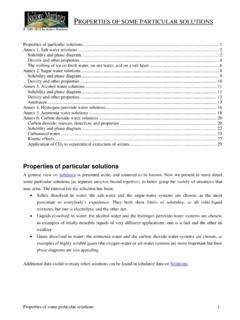Transcription of DEPARTMENT OF THE NAVY
1 DEPARTMENT OF THE navy CHIEF OF NAVAL AIR TRAINING250 LEXINGTON BLVD SUITE 102 CORPUS CHRISTI TX 78419-5041 CNATRASTAFFINST 00 31 Jan 17 CNATRA STAFF INSTRUCTION Subj: CHIEF OF NAVAL AIR TRAINING ANTITERRORISM PLANRef: (a) DODI , DoD Antiterrorism (AT) Standards CH2 of 08 Dec 06 (b) DOD Antiterrorism Officer (ATO) Guide (c) USNORTHCOM Force Protection (FP) Mission and Antiterrorism (AT) Program Instruction 10-222 30 Sep 2013 (d) OPNAVINST (Series), navy Antiterrorism Program 26 May 2009 (e) NTTP Antiterrorism (f) CNRSE AT OPORD 3300 -14, of 07 Jul 14 (g) Naval Air Station Corpus Christi AT Plan Encl: (1) Chief of Naval Air Training Antiterrorism Plan 1. Purpose. To publish Antiterrorism (AT) policy and guidance for the Chief of Naval Air Training (CNATRA) per references (a) through (g).
2 2. Cancellation. CNATRASTAFFINST 3. Scope. This instruction applies to all staff personnel attached to CNATRA including military, DEPARTMENT of Defense (DoD) civilians and Background a. The AT Program is designed with the means and measures to fulfill antiterrorism requirements, safeguard personnel, and protect property. b. The program includes: (1) The safeguarding of property, resources, and personnel during normal operations, Force Protection Conditions (FPCON), and contingencies. (2) Instituting AT situational awareness and establishing security responsibilities. CNATRASTAFFINST 31 Jan 17 2 (3) Providing a degree of protection and deterrence equivalent to the threat. 5. Responsibilities a. CNATRA Chief of Staff (1) CNATRA is responsible for security of its will provide sufficient resources, staff assistance and authority to implement, manage and execute an effective Antiterrorism Program as well as ensure the plan is integrated with the Naval Air Station Corpus Christi (NASCC) AT Plan, reference (g).
3 (2) Identify resources to support the NASCC AT program, per reference (g). b. Commanding Officer, NASCC (1) Will implement the navy AT Program to prevent, deter, detect, plan for, respond to, and mitigate the effects of a terrorist attack within NASCC. (2) Provide all tenants (to include all visiting forces, detachments, etc.) with guidance that integrates them into the NASCC AT plan and identifies requirements in support of the AT mission. c. CNATRA Antiterrorism Officer (ATO) will: (1) Be the technical advisor to CNATRA for all staff AT matters. (2) Provide technical and operational support to staff personnel on AT matters. (3) Be guided in specific duties as delineated in references (a) through (g) and other applicable instructions. (4) Serve as the CNATRA liason to NASCC for all AT-related matters and attend the quarterly NASCC Antiterrorism Working Group (ATWG).
4 CNATRASTAFFINST 31 Jan 17 3 (5) Ensure all staff personnel complete all required AT-related general military training. d. CNATRA Personnel (Military/Civilian/Contractors) will: (1) Comply with the requirements of this instruction. (2) Be sensitive to the presence of strangers (unauthorized persons) in Hangar 42, Building 10 and workspaces and either challenge such individuals or report their presence to a supervisor, the Command Duty Officer or base security. 6. Action. All CNATRA personnel are required to read and comply with this Review Responsibility. ATO is responsible for reviewing and updating of this instruction annually or as changes occur. D. M. EDGECOMB Chief of Staff Distribution:CNATRA Website CNATRA SharePoint DMEDGGECOMBCNATRASTAFFINST 31 Jan 17 Enclosure (1) CHIEF OF NAVAL AIR TRAINING ANTITERRORISM PLAN TABLE OF CONTENTS ANNEX A: ANTITERRORISMANNEX B: PRE-PLANNED RESPONSES Appendix 1: BOMB THREAT Appendix 2: ACTIVE SHOOTER ANNEX C: PROCEDURES FOR SUSPICIOUS PACKAGES AND LETTERS ANNEX D: FPCON LEVELS/DOD TERRORIST THREAT LEVELS Appendix 1: CNATRA FPCON MEASURES ANNEX E: BARRIER PLAN Appendix 1: BARRIER LOCATIONS ANNEX F: SHELTER-IN-PLACE PLAN Appendix 1.
5 SHELTER-IN-PLACE CNATRASTAFFINST 31 Jan 17 Enclosure (1) 2 ANNEX A ANTITERRORISM1. Purpose. Provide information on crisis response procedures in the event of a terrorist attack or threat. 2. Responsibilities. The Commanding Officer (CO), NASCC is responsible for the maintenance of law and order within the grounds and buildings of NASCC. To enforce this authority, the CO may take necessary actions to protect life in the event of a sudden and unexpected terrorist attack or other emergencies. As a tenant, CNATRA will follow the guidelines set by the host activity. Reference (g) provides AT guidance and policy for the tenant commands. 3. Force Protection Conditions (FPCON) Levels and Measures a.
6 FPCONs are per reference (a) and provide a management system that is adaptable to a full spectrum of security describe the progressive measures implemented by all DoD components in response to terrorist threats. FPCONs are the principle means through which a commander applies an operational decision on how to best guard against a threat. These guidelines assist commanders in reducing the effect of terrorist and other security threats to DoD units and activities. This system applies to all personnel assigned to CNATRA Headquarters. b. CNATRA will be notified if a higher FPCON level has been directed. Then CNATRA Chief of Staff (COS) will ensure the FPCONs directed by the NASCC CO are implemented. FPCON measures are mandatory when declared and can be supplemented by additional measures. c. Once the FPCON is declared, all security measures are implemented immediately unless waived by CNATRA. d. There are five FPCONs in current use: NORMAL, ALPHA, BRAVO, CHARLIE, and DELTA.
7 Each FPCON contains progressively increasing AT protective measures with each level. e. CNATRA Specific FPCON measures are located in ANNEX D. f. Installation specific FPCON measures are located in reference (g). CNATRASTAFFINST 31 Jan 17 Enclosure (1) 3 4. Random Anti-Terrorism Measures a. Random Anti-Terrorism Measures (RAMs) complement and supplement, but do not replace the FPCON system. RAMs are measures that enhance security and greatly limit the ability of terrorists to determine patterns of security and measures, such as random inspections of personal bags and limiting access to buildings, are commonly taken from higher FPCON measures to supplement lower ones.
8 B. Reference (g) addresses the RAM program for NASCC. 5. NASCC and Facilities Access a. NASCC Access. As a tenant, CNATRA s access to NASCC is governed by requirements contained in reference (g). b. Access control within CNATRA work spaces is governed by Appendix 1 to Annex Emergency Actions a. In the event of a terrorist incident, the senior person in charge at the time of the incident will determine, based upon situation and/or guidance received from NASCC, the need to evacuate premises, shelter-in-place, etc. b. Senior person in charge will ensure that all personnel exit the premises, when required, in an orderly fashion. Time permitting, they will ensure that all classified material is properly stored; all electrical power is turned off; and all accessible windows, external doors and hangar doors are shut. c. An evacuation type drill ( fire, active shooter or bomb threat) should be held at least annually.
9 Supervisors of handicapped employees will ensure their safe evacuation. This will be accomplished by assigning someone to assist the handicapped employees during an emergency situation. d. Evacuation plans and routes will be posted and include a mustering point for staff personnel to check-in. CNATRASTAFFINST 31 Jan 17 Enclosure (1) 4 ANNEX B PREPLANNED RESPONSES 1. Purpose a. To publish procedures to be carried out upon receipt of a bomb threat (Appendix 1) and an incident involving an active shooter (Appendix 2).2. Action. See Appendix 1 and 2. CNATRASTAFFINST 31 Jan 17 Enclosure (1) 5 APPENDIX 1 to ANNEX B BOMB THREAT PROCEDURES 1.
10 Action a. To avoid any possibility of loss of life and/or damage, it must be assumed that any bomb threat is not a hoax. Major disruptions to normal operations are not desired, but each threat must be treated seriously. All bomb threats will be processed per the below procedures. b. Individual receiving bomb threat will notify: NASCC Police Regional Dispatch at 911. c. After the call is complete: (1) Complete Bomb Threat Incident Checklist (CNATRAINST , enclosure (5)). (2) Provide the responding Security personnel with details of the telephone call. (3) Make a full written record of the conversation and your impressions based on the information annotated on the telephonic bomb information card. d. Upon receipt of warning, the senior person in charge will decide on the need for evacuation. e. If evacuation is necessary, ensure that personnel evacuate according to procedure, and that handicapped employees are provided appropriate assistance.













